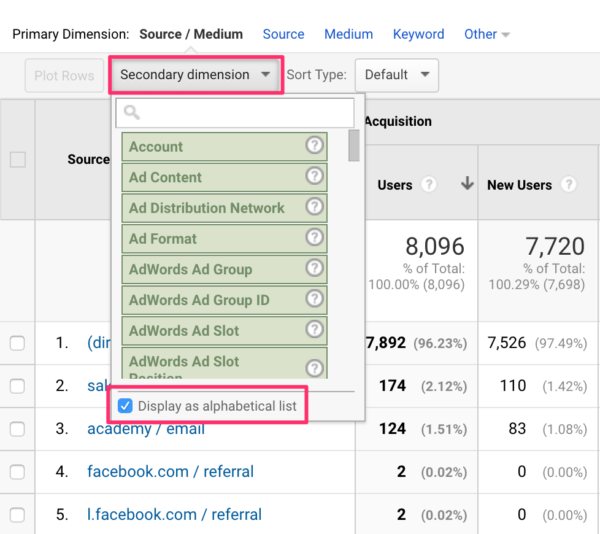Insights into the 'Secondary Dimension' in Google Analytics: A Thorough Explanation
Insights into the 'Secondary Dimension' in Google Analytics: A Thorough Explanation
Blog Article
Navigating the Midst of Additional Measurement in Google Analytics: A Detailed Exploration on Its Performance
Additional measurements, though seemingly simple at first glance, nurture a riches of untapped possible waiting to be used. As we get started on this trip to discover the nuanced functionality of secondary dimensions, we will certainly reveal how this function can light up patterns, unveil correlations, and ultimately lead the means for educated decision-making in the digital landscape (what is a “secondary dimension” in google analytics?).
Comprehending Additional Dimensions in Google Analytics

Comprehending just how secondary dimensions work is crucial for leveraging the complete power of Google Analytics. By incorporating primary metrics with secondary measurements, you can obtain useful understandings that drive notified decision-making and optimization techniques.
Leveraging Additional Measurements for Data Analysis
Structure upon the foundational understanding of exactly how second dimensions boost data evaluation in Google Analytics, the usage of these additional layers of info comes to be critical in removing useful understandings for informed decision-making and optimization approaches. By leveraging second measurements, analysts can dig much deeper into the efficiency metrics by adding more context to the key dimensions, hence uncovering surprise patterns and relationships that might not appear in the beginning glimpse. This much deeper degree of analysis allows services to better understand customer behavior, identify patterns, and identify areas for renovation.
Moreover, additional measurements provide an even more detailed sight of the data, allowing for division based upon numerous parameters such as demographics, gadgets, traffic resources, and much more. This segmentation assists in an extra granular analysis, making it possible for companies to tailor their campaigns and techniques to certain audience segments for boosted targeting and personalization. Essentially, the critical usage of second dimensions encourages companies to make data-driven choices that drive growth and success in the digital landscape.
Advanced Techniques for Secondary Dimension Application
Checking out detailed methods to harness the complete capacity of secondary dimensions in Google Analytics boosts the deepness and elegance of data evaluation for critical decision-making. One sophisticated method for implementing second dimensions is the usage of personalized measurements. Additionally, incorporating second measurements with sophisticated sectors can give even much more granular insights by applying numerous layers of division to the information.
Interpreting Insights Through Second Dimensions

When translating understandings with additional measurements, it is crucial to think about the context of the data and just how various dimensions interact with each other. Understanding which specific web traffic resources lead to greater conversion prices or recognizing which tools users favor for making purchases can provide workable insights for maximizing advertising projects and boosting overall site performance. By thoroughly analyzing the information with secondary measurements in mind, services can make educated choices that drive meaningful results and boost their digital visibility.
Optimizing Performance With Second Dimensions

One crucial way to maximize performance with second dimensions is by segmenting information extra granularly. This permits you to isolate details factors that may be influencing your metrics and obtain a much better understanding of what drives success or failing in your electronic campaigns. By incorporating second measurements such as 'device group' and 'landing page,' you can determine which gadget types are most efficient for particular touchdown web pages, enabling you to tailor your strategies appropriately.
Additionally, utilizing second measurements can aid you recognize trends, patterns, and relationships that may not appear when evaluating data with key dimensions alone. This much deeper level of evaluation can bring about more informed decision-making and ultimately boost the general efficiency of your web site or electronic advertising campaigns.
Verdict
To conclude, secondary measurements in Google Analytics play a crucial function in boosting data evaluation and offering much deeper understandings into site performance. By making use of advanced strategies and interpreting the information effectively, businesses can enhance their strategies and enhance overall efficiency. Recognizing the capability of secondary measurements is crucial for making informed choices and driving success in the digital landscape.
By leveraging second measurements, analysts can dig much deeper into the performance metrics by adding more context to the main dimensions, thus you could look here uncovering concealed patterns and relationships that could not be noticeable at first look. One innovative technique for implementing additional measurements is the use of custom measurements.Having grasped innovative strategies like custom-made dimensions and regex for second measurement execution in Google Analytics, the next vital step is interpreting the valuable insights derived with these innovative information division approaches. Translating understandings through secondary dimensions includes assessing the connections between the additional and primary measurements chosen, revealing patterns, trends, and relationships that may not be quickly apparent when looking at the data in its whole.When translating understandings via secondary measurements, it is necessary to think about the context of the information and just how various dimensions connect with each other.
Report this page